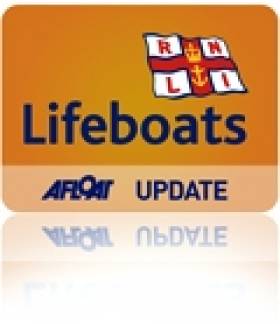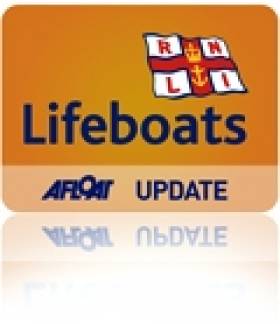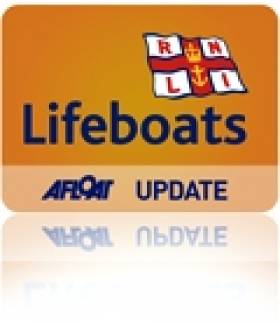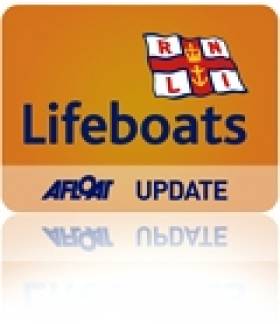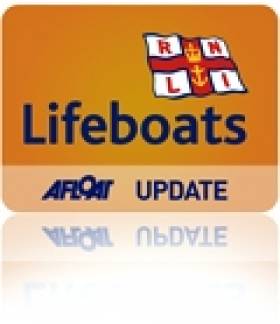Displaying items by tag: Lifeboats
Man Found Safe and Well
The man whom had been thought missing near Baltimore in West Cork has been located safe and well. All rescue services have been stood down. It is a reminder of the importance of letting people know where you are and where you are going.
Both Baltimore Lifeboats Launch on Rescue Missions
Both the all-weather lifeboat and inshore lifeboat based in Baltimore Harbour were called to give assistance on Saturday evening 19th June.
The inshore lifeboat Bessie was called at 18:45 to standby a 58ft motor yacht that was disabled and adrift in Glandore Harbour having hit a rock. Helmsman Youen Jacob assisted by crewmen Kieran Collins and Diarmuid Collins stoody by alongside the Courtmacsherry lifeboat as the motor yacht was towed to safety in Union Hall.
The inshore lifeboat has just been returned to its compound on the pier, when a second alert was raised at 22.25. This time the all-weather lifeboat Hilda Jarrett, responded to a medical emergency on Cape Clear Island. The Public Health Nurse stabilised the casualty prior to the young man being taken on board at North Harbour on Cape Clear Island.. The ambulance service met the lifeboat on its return to Baltimore to transfer the casualty to hospital. The lifeboat was returned to base at 00.10 on Sunday morning. Coxswain Kieran Cotter, was assisted by his crew of Micheal Cottrell, Don O’Donovan, Diarmuid Collins, Brian Ormond, Simon Duggan and John O’Flynn. Remarkably Baltimore lifeboats newest recruit, Diarmuid Collins, attended at both calls.
These two incidents demonstrate the versatility of the RNLI lifeboat capacity at Baltimore. The inshore lifeboat is a twin engine Atlantic 75 RIB, purpose designed for rapid response to inshore emergencies, whilst the larger all-weather lifeboat is suited to long range calls and medical evacuations.
Crosshaven Lifeboat Rescues 18-foot Yacht
Crosshaven RNLI Lifeboat went to the aid of an eighteen foot yacht on passage from the Kinsale area to Crosshaven this evening. The yacht with two persons on board suffered mechanical failure and was having trouble making way into a headwind.
Initially, the yacht was assisted by the motor Cruiser “Callie” who took them on initial tow and informed the Coastguard in Valentia who made the decision to Launch the Crosshaven lifeboat at 7pm. The Volunteer crew made up of Helm Con Crowley with Vincent Fleming and Ritchie Kelleher made their way to the rendezvous between the Cork Bouy and Rennies Point and relieved the motor cruiser of the tow. Crewman Ritchie Kelleher
Boarded the yacht and helped rig the tow for the 40 minute journey back to Crosshaven where the yacht was secured.
Swansea Lifeboat in Multiple Rescues
The warm weather has brought on a string of incidents for Swansea Coastguard, who this afternoon have co-ordinated several rescues, including three missing children, a capsized kayak and an injured jet-skier.
Several resources in particular were sent by Swansea Coastguard to assist in the search for a 5-year-old girl at Burnham-on-Sea beach this afternoon. The girl was reported missing via a 999 call to the Coastguard made by her father at 20 past 2. Swansea Coastguard sent Coastguard Rescue Teams from Burnham-on-Sea and Weston Super Mare, as well as the Burnham Hovercraft, Avon and Somerset Police (including their helicopter), and the two Burnham RNLI inshore lifeboats to perform a shoreline search at Berrow at Burnham-on-Sea.
After an hour-and-a-half of searching the girl was located by Police units who found the girl with a beach warden and returned her safely to her family.
Swansea Coastguard also co-ordinated the searches of a missing 6-year-old girl this morning, also at Burnham, and a missing 5-year-old boy at Rhossili.
In other incidents, a kayaker was rescued by the Mumbles RNLI lifeboat after capsizing and Rhossili Coastguard Rescue Team were sent to the rescue of a female seriously injured in a jet ski incident on the beach at Port Eynon, Gower. The Coastguards assisted paramedics to evacuate the female onto the air ambulance, where she was taken to hospital.
Swansea Coastguard Watch Manager Dai Jones said:
“We have had an extremely busy afternoon, with many incidents brought on by the warm weather. We would like to remind members of the public to be vigilant when taking children to the beach as, on days like this when the beaches are packed with people, it only takes a child to disappear from view for a second before they can become lost.”
Bangor Lifeboat Assists 18ft Motor Boat
RNLI Bangor Lifeboat launched at 1:20 pm on Monday 17th May 2010 to assist a person aboard an 18ft leisure motor boat which had experienced engine failure.
Within minutes of the rescue pagers being activated, volunteer crew had launched RNLI Bangor Lifeboat and quickly located the disabled vessel 300 metres from the shore close to Crawfordsburn beach on the southern shores of Belfast Lough.
Calm on scene weather conditions allowed for a tow line to be quickly rigged and the boat was towed to the safety of Bangor Marina RNLI volunteer helmsman Peter Scott who was involved in this rescue said ‘We always urge everyone going afloat to make sure their electrical systems and engine are well maintained and in good working order. Engine failure so close to shore could lead to a life threatening situation’.
Ballycotton Lifeboat Tows Fishing Boat
Ballycotton RNLI lifeboat launched at 04:10 this morning, Sunday 9 May, for the second time in one night. They went to assist a 44ft Irish fishing vessel with a fouled propeller 37 miles south east of Ballycotton. The wind at the time had picked up and conditions were fresh. A towline was established and the fishing vessel is being towed to Ballycotton.
Art Exhibition in aid of RNLI
Philip O’ Byrne, Cork artist will be holding an art exhibition in aid of the RNLI at the Hall of Frames Gallery, Donnybrook, Douglas from Friday May 14th to Sunday May 16th. The theme of the painting is “From Hook Head to Loop Head” and will include many maritime own works as well as works from other local artists. A painting of the Courtmacsherry lifeboat off the Cork coast and a framed Admiralty chart of Cork to Kenmare will be sold to highest offers in aid of RNLI. There will also be a raffle for your choice of painting by the artist.
The exhibition will be opened by Tom MacSweeney, Marine correspondent on Friday evening at 7:30pm
The RNLI relies on donations and money raised through fundraisers. It costs €1200 to train a volunteer for one year. This art exhibition hopes to raise at least this amount. This is an opportunity to help the RNLI and acquire some art. Prices range from €50 to €500 Any enquiries to Philip O Byrne 087 2646978 or see his popst on the Afloat forum here.
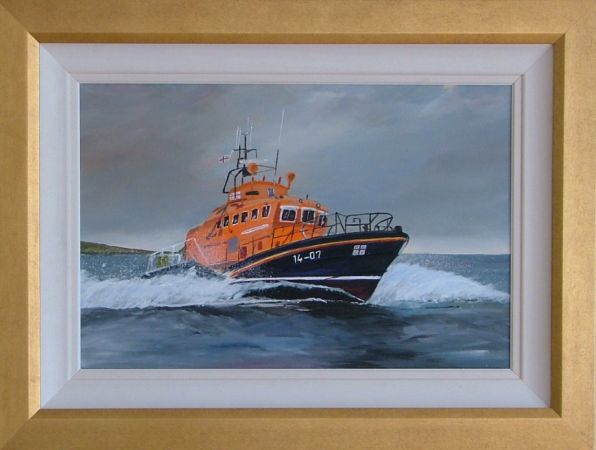
Donaghadee RNLI Crew Members to Receive Awards
Seven lifeboat Crew Members from Donaghadee RNLI lifeboat station are to be recognised by the Royal National Lifeboat Institution for their part in an early morning rescue that took place in horrendous weather conditions and resulted in three lives being saved.
The callout happened just after 2am on the morning of 13 September 2009, when the yacht Bentim Buoys with three crew onboard was on passage from the Isle of Man to Bangor and ran aground.
Coxswain Philip McNamara is to be accorded the Thanks of the Institution on Vellum while Deputy Second Coxswain John Ashwood, Mechanic Shane McNamara, Crew Members Stephen McComiskey, David McCormack, Richard McGimpsey, and John Petrie will each receive a Vellum Service Certificate. The Vellum award from the RNLI is for services that show great skill and expertise by the lifeboat crew, often carried out in very difficult condition.
The service lasted just under four hours but in that time the lifeboat crew had to deal with deteriorating weather conditions, which were battering the lifeboat and the grounded vessel. They also had to plan and put into practice several attempts to bring the crew and the vessel to the safety of Donaghadee harbour when the worsening seas prevented the standard rescue procedures.
At 2.15 am on the morning of 13 September 2009 the lifeboat crew’s pagers were activated to go to the aid of a 10 metre yacht which had run aground on Craig Brain Rocks. En route to the scene the lifeboat met with poor weather conditions. Once exposed to open water the wind was force 5 with the swell reaching 2 metres and worsening. As the lifeboat crew approached the yacht they could see it was in imminent danger of breaking up.
Lifeboat Coxswain Philip McNamara used great skill in manoeuvring the lifeboat in difficult seas. Two lifeboat crew launched a small craft from the lifeboat, which allows close access to the shore. From that Richard McGimpsey and David McCormack attempted to board the vessel but they were swept out into the sea and had to return to the lifeboat using paddles. The crew on the casualty vessel were unable to leave their yacht and so the decision was taken by the Coxswain to attempt to establish a tow and drag the yacht off the rocks, hoping that the vessel would float.
Several attempts were made to establish a line from the lifeboat to the yacht, which were severely hampered by the weather. Finally at 3.30am a line was established and secured onto the yacht. The vessel started to come upright but the line parted. Lifeboat Mechanic Shane McNamara had prepared a second towline and finally at 3.39am the yacht came upright, moved along the rocks and refloated. However the tow then parted and the yacht was cast adrift and in great danger of grounding a second time.
The lifeboat crew reacted immediately and recovered the towline. The Coxswain once again manoeuvred the lifeboat close to the yacht and the tow was re-established. The yacht and her three shaken crew were then taken back to Donaghadee with no serious injuries.
Commenting on the service RNLI Divisional Inspector for Ireland Martyn Smith said, ‘These vellums are well deserved for what was an extraordinary service, resulting in three lives being saved. Split second decisions were made by the Coxswain in horrendous conditions. The lifeboat crew were operating in an area where local knowledge was vital and they used this to great effect. The Coxswain also had to manoeuvre the lifeboat very carefully, as the lifeboat crew attempted to bring the yacht and her crew to safety.
‘This all happened in the middle of the night and under very challenging conditions. With the lifeboat rolling in heavy seas various scenarios and options were worked out by the crew, which ultimately ensured the safe recovery of the three men and their yacht. I want to pay tribute to the lifeboat crew lead by Coxswain Philip McNamara for this incredible service.”
The presentation of the awards to the lifeboat crew will be made later in the year.
Family of an Irish fisherman became concerned when his 14 metre fishing vessel failed to return to harbour at 23:30. Attempts were made to contact the fisherman by radio and phone but to no avail. Ballycotton RNLI lifeboat station was contacted at 01:00 and the crew pagers were activated.
The Ballycotton RNLI lifeboat, Austin Lidbury, was given the last known position of the fishing vessel and they proceeded to the area 8 miles south east of Ballycotton lighthouse. The Waterford based Coastguard helicopter, Rescue 117, was also launched. When close to the vessel’s last known position a red flare was spotted by the Ballycotton lifeboat and the fisherman was found safe and well in a life raft. It is understood he had been in the life raft for approx. four hours. He was taken aboard the RNLI lifeboat where his condition was assessed. He was safely landed ashore in Ballycotton where his family awaited his return.
Donaghadee RNLI Crew Members to Receive Awards
Seven lifeboat Crew Members from Donaghadee RNLI lifeboat station are to be recognised by the Royal National Lifeboat Institution for their part in an early morning rescue that took place in horrendous weather conditions and resulted in three lives being saved. The callout happened just after 2am on the morning of 13 September 2009, when the yacht Bentim Buoys with three crew onboard was on passage from the Isle of Man to Bangor and ran aground.
Coxswain Philip McNamara is to be accorded the Thanks of the Institution on Vellum while Deputy Second Coxswain John Ashwood, Mechanic Shane McNamara, Crew Members Stephen McComiskey, David McCormack, Richard McGimpsey, and John Petrie will each receive a Vellum Service Certificate. The Vellum award from the RNLI is for services that show great skill and expertise by the lifeboat crew, often carried out in very difficult condition.
The service lasted just under four hours but in that time the lifeboat crew had to deal with deteriorating weather conditions, which were battering the lifeboat and the grounded vessel. They also had to plan and put into practice several attempts to bring the crew and the vessel to the safety of Donaghadee harbour when the worsening seas prevented the standard rescue procedures.
At 2.15 am on the morning of 13 September 2009 the lifeboat crew’s pagers were activated to go to the aid of a 10 metre yacht which had run aground on Craig Brain Rocks. En route to the scene the lifeboat met with poor weather conditions. Once exposed to open water the wind was force 5 with the swell reaching 2 metres and worsening. As the lifeboat crew approached the yacht they could see it was in imminent danger of breaking up.
Lifeboat Coxswain Philip McNamara used great skill in manoeuvring the lifeboat in difficult seas. Two lifeboat crew launched a small craft from the lifeboat, which allows close access to the shore. From that Richard McGimpsey and David McCormack attempted to board the vessel but they were swept out into the sea and had to return to the lifeboat using paddles. The crew on the casualty vessel were unable to leave their yacht and so the decision was taken by the Coxswain to attempt to establish a tow and drag the yacht off the rocks, hoping that the vessel would float.
Several attempts were made to establish a line from the lifeboat to the yacht, which were severely hampered by the weather. Finally at 3.30am a line was established and secured onto the yacht. The vessel started to come upright but the line parted. Lifeboat Mechanic Shane McNamara had prepared a second towline and finally at 3.39am the yacht came upright, moved along the rocks and refloated. However the tow then parted and the yacht was cast adrift and in great danger of grounding a second time.
The lifeboat crew reacted immediately and recovered the towline. The Coxswain once again manoeuvred the lifeboat close to the yacht and the tow was re-established. The yacht and her three shaken crew were then taken back to Donaghadee with no serious injuries.
Commenting on the service RNLI Divisional Inspector for Ireland Martyn Smith said, ‘These vellums are well deserved for what was an extraordinary service, resulting in three lives being saved. Split second decisions were made by the Coxswain in horrendous conditions. The lifeboat crew were operating in an area where local knowledge was vital and they used this to great effect. The Coxswain also had to manoeuvre the lifeboat very carefully, as the lifeboat crew attempted to bring the yacht and her crew to safety.
‘This all happened in the middle of the night and under very challenging conditions. With the lifeboat rolling in heavy seas various scenarios and options were worked out by the crew, which ultimately ensured the safe recovery of the three men and their yacht. I want to pay tribute to the lifeboat crew lead by Coxswain Philip McNamara for this incredible service.”
The presentation of the awards to the lifeboat crew will be made later in the year.



























